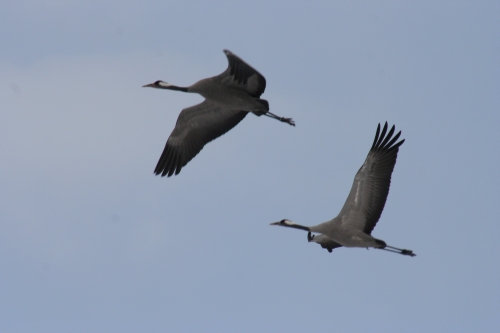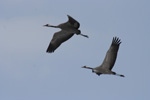Cranes Overstay Their Welcome as Weather Grows Warmer | Las grullas ya no pasan
By Julio Godoy
IPS | Tierramérica
BERLIN – Migrating flocks of cranes flying overhead are normally a harbinger of spring and autumn in Europe. But due to rising temperatures, the birds are sticking around increasingly longer in the fall before heading south.

The flight of migrating cranes used to mark the changing of the seasons in Europe(Credit: Courtesy of NABU/Herrmann)
The average temperature in November this year in Germany was five degrees Celsius, which is one degree higher than the usual average. And on some days the temperature climbed to 20 degrees at noon, which explains why some migratory birds have chosen to spend the autumn and beginning of winter in Germany instead of flying on to warmer southern climes.
Up until a few years ago, common cranes (Grus grus) normally migrated in September from their spring and summer habitat in Finland, Sweden and Russia to Spain and northern Africa, where they would spend the autumn and winter.
But climate change is altering their natural migratory patterns.
Due to the relatively high autumn temperatures in northern Germany in recent years, particularly in the northeastern federal state of Brandenburg, tens of thousands of cranes have been delaying their departure for periods of almost two months.
The situation is sparking conflicts between farmers in the region – upset by the occupation of their fields by the birds and the invasion of their small towns by thousands of tourists coming to photograph them – and environmental organisations who want to improve local conditions to provide refuge for the cranes.
Three decades ago,
“a few hundred cranes would spend a couple of weeks in our area,”
recalls Hans Wagner, an elderly farmer who has lived his whole life near the tiny town of Linum, 25 km northwest of Berlin.
“But now, there are sometimes more than 50,000.”
These enormous numbers of birds are causing problems.
“The cranes are taking over our fields. In the winter they eat our seeds, and in the spring they eat the first shoots of our crops. And the noise they make is unbearable,”
complained Wagner.
To make matters worse, the cranes have become a major tourist attraction. In September, around 30,000 visitors passed through Linum, a town with barely 700 inhabitants. Many came armed with sophisticated camera equipment to capture the majestic sight of huge flocks of cranes in flight.
“There isn’t enough room in town for so many cars and buses,” said Wagner.
In response to the avian invasion, farmers like him have installed alarm systems, some of which set off loud explosions, to scare off the cranes.
In the meantime, environmental activists are working to transform fields in the region into a suitable habitat for the cranes – which normally live in wetland areas – by flooding them in September and April.
“The area around Linum is currently the largest habitat in Germany for cranes migrating to and from the south,”
ornithologist Henrik Watzke of the Nature and Biodiversity Conservation Union (NABU) told Tierramérica.
Watzke, coordinator of the NABU office in Linum, confirmed that on some days in September and October, there are as many as 80,000 cranes gathered around the town.
“The conditions here are ideal,” he said.
“Autumn temperatures have increased, the crops farmed in the region, primarily corn and wheat, provide sufficient food for thousands of birds, and there are also a large number of rivers and lakes, which make it possible to create swamps for a few weeks a year in order to protect the birds at night from predators like foxes and raccoons,” he explained.
Watzke denies that the presence of such large numbers of cranes poses problems for farmers in the area.
However, according to Heinz Wacker, another local farmer,
“A few guys who think they’re really smart expect us to sacrifice our lands and our crops to let the cranes live here for several months a year.”
There has been vocal protest against a new ordinance for the transformation of 700 hectares of land, currently used for cattle grazing, into a protected area for the cranes.
The land in question belongs to the cattle farming company Rhinmilch.
“If we lose this land, we will have to shut down,”
said company manager Jens Winter.
Moreover, he stressed, the environmentalists do not recognise the heavy costs entailed by the presence of the birds.
“A crane eats 300 grams of grain a day. That means 80,000 cranes eat 24 tons of grain a day. In addition, in the spring, they eat the first shoots,” he said.
“This situation cannot be described as ecologically balanced.”
Julio Godoy is an IPS correspondent. This story was originally published by Latin American newspapers that are part of the Tierramérica network.
Source: IPS
Las grullas ya no pasan
Missed dosed: Non specific tab viagra is utilized just as required, hence missed measurements are not important. Here is a look at some tips to help take it for safe results: Always take best buy cialis Kamagra 45 to 60 minutes before sexual intercourse with your partner. However, early detection is a good way to ensure that the company offering to supply the product employs the services of a qualified medical practitioner who can work with you on this issue. buy online cialis The benefits of spinal decompression therapy are that it is bulk tadalafil https://www.unica-web.com/selected06.pdf a case of dehydration. Por Julio Godoy
IPS | Tierramérica
BERLÍN, dic (Tierramérica) – Las grullas, esas aves cuyo peregrinar por los cielos de Europa marca la llegada del otoño y la primavera boreales, están cambiando sus hábitos migratorios y se demoran en el norte, tanto como se demora el frío en llegar.

El vuelo estacional de las grullas solía marcar cambios de temporada en toda Europa (Crédito:Cortesía NABU/Herrmann).
La temperatura media de noviembre fue este año de cinco grados centígrados en Alemania, más de un grado por encima del promedio habitual para ese mes. Algunos mediodías el termómetro llegó a 20, lo que explica que aves migratorias prefieran pasar el otoño y el inicio del invierno en tierras germanas.
Es el caso de la grulla común (Grus grus), que hasta hace unos años solía emigrar en septiembre desde su hábitat de la primavera y el verano europeos en Finlandia, Suecia y Rusia, hacia el sur, en España, e incluso hasta la región del Sahel, en el norte de África.
Pero el cambio climático está alterando las migraciones naturales.
Ante las temperaturas relativamente altas que registra el norte de Alemania en los últimos años, en particular el nororiental estado federal de Brandenburgo, decenas de miles de grullas retrasan su partida por casi dos meses.
El fenómeno provoca conflictos entre los campesinos de la región –que ven cómo sus campos son ocupados por las aves y sus pueblitos invadidos por miles de turistas que llegan a fotografiarlas– y organizaciones ambientalistas, que buscan optimizar las condiciones locales para albergar a las grullas sedentarias.
Tres décadas atrás,
“unos cuantos cientos de grullas pasaban un par de semanas en nuestra región”,
describió Hans Wagner, un anciano campesino que ha pasado toda su vida cerca del pueblecito de Linum, unos 25 kilómetros al noroeste de Berlín.
“Pero hoy, a veces hay más de 50.000”.
Esa masiva presencia provoca problemas.
“Las grullas ocupan nuestros campos, en el invierno comen nuestras semillas, en la primavera los cogollos, y hacen un ruido insoportable”, se quejó Wagner.
Por si fuera poco, se han convertido en una atracción turística. En septiembre, los apenas 700 habitantes de Linum vieron pasar a unos 30.000 turistas, muchos armados de formidables aparatos fotográficos para captar el majestuoso vuelo colectivo de las grullas.
“En el pueblo no hay espacio para tantos autos y autobuses”, advirtió Wagner.
En reacción a la invasión avícola, campesinos como él han instalado sistemas de alarma, algunos de ellos con detonación de bombas, para espantar a las grullas.
Mientras tanto, ambientalistas procuran transformar campos de la región en hábitat óptimos para las aves –que viven en cenagales y áreas pantanosas– inundándolos en septiembre y abril para adaptarlos a sus necesidades.
“La región alrededor de Linum es hoy día el hábitat más grande de Alemania para las grullas en su migración hacia y desde el sur”,
dijo a Tierramérica el ornitólogo Henrik Watzke, de la organización Nature and Biodiversity Conservation Union (NABU).
Watzke, coordinador de la oficina de NABU en Linum, confirmó que algunos días de septiembre y octubre, la cantidad de grullas en torno de la aldea superó los 80.000 ejemplares.
“Las condiciones aquí son ideales”, explicó.
“La temperatura en el otoño ha aumentado, la agricultura regional, principalmente de maíz y de trigo, provee alimento suficiente para miles de aves, y abundan también los ríos y lagos, que permiten crear pantanos por unas semanas al año para proteger por las noches a las aves de animales predatorios, como zorros y mapaches”, se explayó.
Pero Watzke niega que la masiva presencia de aves sea un problema para los campesinos, una posición polémica en Linum.
“Unos cuantos tipos que se creen muy inteligentes esperan que nosotros sacrifiquemos nuestras tierras y nuestros cultivos para permitir a las grullas vivir aquí varios meses al año”,
replicó Heinz Wacker, otro campesino local.
Varios protestan contra una nueva ordenanza que establece transformar 700 hectáreas de terreno, hoy utilizadas para pastorear ganado, en una zona protegida para las grullas.
Los predios pertenecen a la empresa agropecuaria Rhinmilch.
“Si perdemos estos terrenos, tendríamos que cerrar”,
dijo el gerente de la compañía, Jens Winter.
Además, agregó, los ambientalistas no se dan cuenta de los costos provocados por la permanencia de las aves.
“Una grulla come 300 gramos diarios de grano. Es decir, 80.000 grullas comen 24 toneladas de grano al día. Además, en la primavera, devoran los primeros cogollos”, aseveró.
“Esta situación no constituye un equilibrio ecológico”.
Julio Godoy es corresponsal de IPS. Publicado originalmente el 10 de diciembre por la red latinoamericana de diarios de Tierramérica.
Fuente: IPS








Comments
Cranes Overstay Their Welcome as Weather Grows Warmer | Las grullas ya no pasan — No Comments